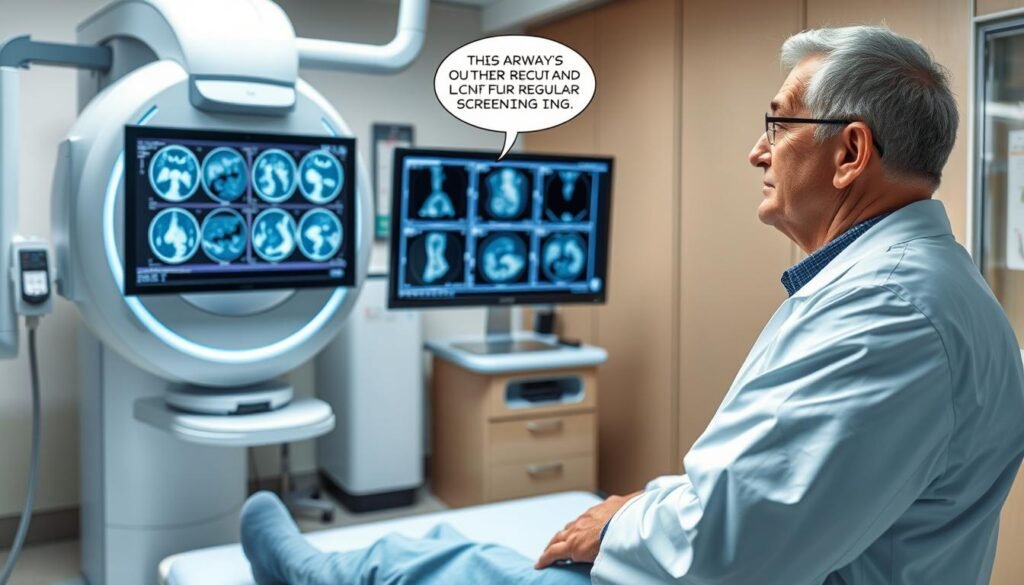
Taking care of your health is one of the most important steps you can take. Regular health checks, like cancer screening, play a vital role in detecting potential issues early. These tests are designed to find problems before symptoms appear, which can lead to more effective treatment and better outcomes.
Early detection is key. When health concerns are identified sooner, the chances of successful care increase significantly. However, it’s important to understand that these tests come with both benefits and risks. For example, false-positive or false-negative results can occur, which is why staying informed is crucial.
Our guide is based on the latest research and expert recommendations. We aim to provide clear information and practical advice to help you understand what to expect during the process. By working closely with your health care provider, you can make informed decisions about your well-being.
Key Takeaways
- Regular health checks can detect issues early, improving outcomes.
- These tests are done before symptoms appear.
- Early detection reduces the risk of advanced disease.
- False results are possible, so staying informed is essential.
- Follow up-to-date guidelines for the best care.
Understanding Cancer Screenings
Understanding the purpose of health tests can help us take control of our well-being. These screening tests are designed to identify potential health issues before symptoms develop. Their primary goal is early detection, which can lead to more effective treatment and better outcomes.

Definition and Purpose
A screening test is a proactive measure used to detect abnormalities in individuals who show no symptoms. These tests are not meant to diagnose a condition but to identify risks early. For example, a mammogram is a common screening test used to detect breast abnormalities before they become problematic.
Early detection is crucial. It allows for timely intervention, which can significantly improve health outcomes. By identifying risks early, we can take steps to manage or even prevent serious conditions.
Screening vs. Diagnostic Testing
It’s important to understand the difference between screening and diagnostic testing. A screening test is performed on asymptomatic individuals to identify potential risks. If abnormalities are found, a diagnostic test is used to confirm the presence of a condition.
For instance, a colonoscopy may be used as a screening test for colon health. If polyps are detected, further diagnostic testing is required to determine if they are cancerous. This distinction helps us make informed decisions about our health care.
Here’s a quick comparison of the two types of testing:
| Screening Test | Diagnostic Test |
|---|---|
| Performed on asymptomatic individuals | Used to confirm a suspected condition |
| Identifies potential risks | Provides a definitive diagnosis |
| Examples: Mammogram, Pap smear | Examples: Biopsy, MRI |
The right screening test depends on factors like a person’s age, family history, and individual risk factors. Understanding these distinctions empowers us to take charge of our health and make informed decisions.
The Benefits and Risks of Early Detection
Detecting health issues early can make a world of difference in treatment outcomes. When we find cancer before symptoms appear, it’s often easier to treat or even cure. This proactive approach can significantly improve survival rates and reduce the burden of advanced disease.

However, it’s important to understand that early detection isn’t without its challenges. False-positive or false-negative results can occur, leading to unnecessary anxiety or missed opportunities for care. We must weigh the benefits against these potential risks to make informed decisions.
Advantages of Finding Cancer Early
One of the most significant benefits of early detection is the ability to act quickly. When health concerns are identified at an early stage, treatment options are often less invasive and more effective. For example, catching a sign of trouble before it escalates can prevent the need for aggressive therapies later.
Here are some key advantages:
- Improved survival rates due to timely intervention.
- More treatment options available at earlier stages.
- Reduced risk of complications from advanced conditions.
Managing Risks and False Results
While early detection offers many benefits, it’s not without its limitations. False-positive results can lead to unnecessary follow-up tests and procedures, causing stress and anxiety. On the other hand, false-negative results may provide a false sense of security, delaying necessary care.
Overdiagnosis is another concern. This occurs when a test identifies a condition that may never have caused harm, leading to unnecessary treatment. Understanding these risks helps us make balanced decisions about our health care.
Here’s how to manage these challenges:
- Discuss your cancer risk factors with your health care provider.
- Stay informed about the limitations of screening tests.
- Weigh the benefits and risks based on your individual needs.
By staying informed and proactive, we can make choices that prioritize our well-being while minimizing potential downsides.
What to Expect During Your Screening Process
Knowing what to expect during a health check can ease your mind and help you prepare. Whether it’s your first scan or a routine appointment, understanding the process ensures a smoother experience. We’ll walk you through the steps, from preparation to the actual test, so you feel confident and informed.
Preparing for Your Appointment
Preparation is key to a successful screening. Start by gathering important information, such as your medical history and any previous test results. Write down questions you may have for your health care provider. This ensures you make the most of your time together.
For specific tests like a mammogram, follow any pre-appointment instructions. This might include avoiding certain products or wearing comfortable clothing. Staying organized and informed helps reduce anxiety and ensures a smoother process.
Overview of the Screening Procedure
On the day of your appointment, you’ll typically check in and complete any necessary paperwork. The procedure itself varies depending on the test. For example, a mammogram involves a quick scan of the breast area, while other tests may require blood work or imaging.
Most screenings are quick, often taking less than an hour. Your health care provider will guide you through each step, ensuring you’re comfortable and informed. Following their recommendation is crucial for accurate results and optimal care.
Here’s what to expect during common tests:
- Mammogram: A quick imaging test for breast health, recommended annually or biennially depending on age.
- Blood tests: Simple and fast, often used to check for markers of concern.
- Imaging scans: Non-invasive and painless, providing detailed insights into your health.
By understanding the process and preparing ahead of time, you can make your screening experience as stress-free as possible. Regular checks are an essential part of maintaining your lifelong health.
Key Cancer Screening Tests and Procedures
Modern medicine offers a range of tests to identify health concerns early. Choosing the right one depends on factors like age, family history, and individual risk. Each test has its own procedures, benefits, and limitations. Staying informed helps us make the best decisions for our well-being.
Common Tests for Breast, Cervical, Lung, and Colon Cancer
Several tests are widely used to detect specific types of cancer. For breast cancer, a mammogram is the most common screening tool. It uses low-dose X-rays to identify abnormalities in breast tissue. Regular mammograms are recommended for women over 40.
For cervical cancer, a Pap smear is the standard test. It collects cells from the cervix to check for abnormalities. This test is typically recommended every three to five years for women aged 21 to 65.
Lung cancer screening often involves a low-dose CT scan. This imaging test is recommended for heavy smokers or those with a history of smoking. It helps detect lung nodules or tumors at an early stage.
For colon health, a colonoscopy is the gold standard. This procedure examines the entire colon and removes polyps if found. It’s recommended every ten years for adults over 45.
Cutting-Edge Screening Technologies
Innovative tests are changing the way we approach early detection. The Galleri blood test, for example, can detect multiple types of cancer from a single blood sample. While still in development, it shows promise for improving outcomes.
Other advancements include liquid biopsies and AI-driven imaging. These technologies aim to make screenings more accurate and less invasive. Staying updated on these developments can help us take proactive steps toward better health.
| Test | Purpose |
|---|---|
| Mammogram | Detects breast abnormalities |
| Pap smear | Identifies cervical cell changes |
| Low-dose CT scan | Screens for lung nodules |
| Colonoscopy | Examines colon health |
By understanding these tests and staying informed about new technologies, we can take charge of our health and make informed decisions. Early detection remains a powerful tool in improving outcomes and quality of life.
What You Need to Know about Cancer Screenings
Making informed choices about health tests empowers us to take control of our well-being. Understanding the risks and benefits of these tests is essential for making decisions that align with our individual needs. We’ll explore how shared discussions with your care provider can lead to personalized care and better outcomes.
Understanding Risks and Benefits
Every test comes with its own set of advantages and potential drawbacks. For example, a woman may benefit from regular mammograms, but it’s important to weigh the risk of false positives. Similarly, tests for prostate health may not be necessary for everyone. Knowing these details helps us make choices that suit our unique circumstances.
“The key is to balance the benefits of early detection with the potential harms,” says a leading health care expert. This balance ensures that we’re not overtesting or missing opportunities for early intervention.
Shared Discussions with Your Care Provider
Open conversations with your care provider are crucial. They can help you understand which tests are right for you based on factors like age, family history, and personal risk cancer factors. For instance, a woman with a family history of type cancer may need more frequent screenings.
Here are some tips for productive discussions:
- Ask about the benefits and risks of each test.
- Discuss how your lifestyle or family history affects recommendations.
- Seek clarity on follow-up steps if results are abnormal.
By staying informed and proactive, we can make decisions that prioritize our health and well-being. Regular check-ups and open communication with your care provider are the foundation of personalized care.
Conclusion
Regular health checks are a powerful tool for staying ahead of potential issues. They play a vital role in early detection, especially for conditions like colon cancer and lung health concerns. However, it’s essential to weigh the benefits against potential risks.
We’ve highlighted the importance of understanding both the advantages and challenges of these tests. Early detection can lead to better outcomes, but false results and overdiagnosis are possible. Staying informed helps us make balanced decisions.
Embracing change in how we approach health care is key. Regular dialogue with your care provider ensures personalized recommendations. Together, we can navigate complex options and prioritize well-being.
Our commitment remains clear: to provide evidence-based information that empowers you to take charge of your health. Let’s stay proactive and informed for a healthier future.